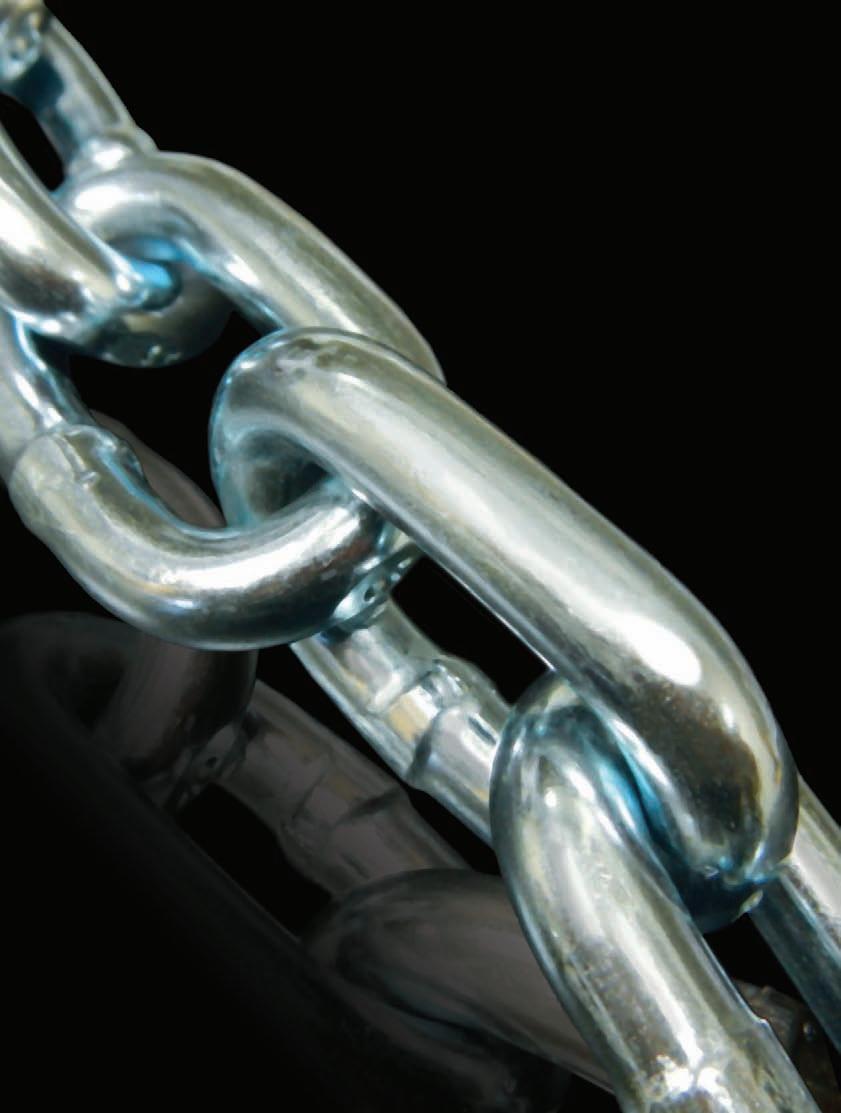

























































The


population is projected to more than double, from 53.3 million in 2012 to 128.8 million in 2060, while the black population is expected to increase from 41.2 million to 61.8 million over the same period.































































The


population is projected to more than double, from 53.3 million in 2012 to 128.8 million in 2060, while the black population is expected to increase from 41.2 million to 61.8 million over the same period.




This month, Carlo Calma, new to the American Coin-Op staff, takes a look at wash/dry/fold service and how working to perfect it can present some real profit potential.
Running a self-service laundry can be, if you let it, an impersonal endeavor. You could open your store in the morning (unless it’s a 24/7 facility, of course), make sure the lights are on, check that the equipment is functional, and leave. I’m talking less than 10 minutes, in and out without seeing or speaking to a soul.
But taking on wash/dry/fold service and/or commercial work demands that an operator take a personal approach to his or her business. Being unresponsive or absent is not an option when you’re in a service business.
Elsewhere in this month’s issue, longtime small-business columnist Howard Scott urges store owners to know their customers. Sending your manager or attendant out to chat with folks in your store won’t provide the insight you need, Scott opines, nor will being around every day to shoot the breeze while the locals wait for the drums to stop spinning.
No, Scott says, it’s going to take setting aside a half-hour or hour each time you’re in the store to actively engage customers in conversation about more than the weather or politics. He suggests that learning each customer’s name and jotting down notes as they answer your questions will demonstrate that you’re sensitive to their needs and want to provide them with the best service.
Show interest in your customers and they will help you build a better business.
Bruce Beggs Editorial DirectorCharles Thompson, Publisher
E-mail: cthompson@ americantrademagazines.com Phone: 312-361-1680
Bruce Beggs, Editorial Director
E-mail: bbeggs@ americantrademagazines.com Phone: 312-361-1683
Roger Napiwocki, Production Manager
Jean Teller, Contributing Editor
Carlo Calma, Editorial Assistant
Nathan Frerichs, Digital Media Director
E-mail: nfrerichs@ americantrademagazines.com Phone: 312-361-1681
Donald Feinstein, Natl. Sales Director E-mail: dfeinstein@ americantrademagazines.com Phone: 312-361-1682


Main: 312-361-1700 Fax: 312-361-1685
suBscriptions
630-739-0600 www.AmericanCoinOp.com
American Coin-Op (ISSN 0092-2811) is published monthly. Subscription prices, payment in advance: U.S. and Possessions, 1 year $39.00; 2 years $73.00. Foreign, 1 year $89.00; 2 years $166.00. Single copies $7.00 for U.S. and Possessions, $14.00 for all other countries. Published by American Trade Magazines LLC, 566 West Lake Street, Suite 420, Chicago, IL 60661. Periodicals postage paid at Chicago, IL and at additional mailing offices.
POSTMASTER, Send changes of address and form 3579 to American Coin-Op, Subscription Dept., 440 Quadrangle Drive, Suite E, Bolingbrook, IL 60440. Volume 54, number 2. Editorial, executive and advertising offices are at 566 West Lake Street, Suite 420, Chicago, IL 60661. Charles Thompson, President and Publisher. American Coin-Op is distributed selectively to owners, operators and managers of chain and individually owned coin-operated laundry establishments in the United States. No material appearing in American Coin-Op may be reprinted without written permission. The publisher reserves the right to reject any advertising for any reason.
© Copyright AMERICAN TRADE MAGAZINES LLC, 2013. Printed in U.S.A.






More than half of respondents to January’s AmericanCoinOp. Wire survey say business was good (39.3%) or even great (14.3%) last year, while another 28.6% say 2012 business was average. The remainder—17.9%—call it below average.
Regardless of how their individual business fared, 58.6% say 2012 turned out as they expected. Thirty-one percent didn’t expect last year’s business results, and 10.3% weren’t sure what to expect in 2012.
Respondents were asked to list the best thing that happened to their laundry in 2012. There were some expected responses, such as increasing or maintaining sales, adding commercial business, attracting more customers and putting in new equipment. Some mentioned the closing of nearby competitors.
And how about the worst thing to happen last year? The increasing cost of utilities, dealing with competition, and the re-election of Barack Obama received multiple mentions.
Weather factored into at least two responses: lightning struck one operator’s building and caused damage to many machines, while another had to make numerous repairs after a large hailstorm.
One respondent said opening a new store was both the best thing and the worst thing to have happened last year.
So, what does 2013 hold for the respondents? They’re planning to spruce up their stores (63.3%), raise vend prices (56.7%), add new washers and/or dryers (50%), and do more marketing (40%). Shares of less than 10% will add other equipment or another service. Ten percent don’t plan to make changes this year.
Roughly 53% expect their business will improve in 2013, while 16.7% expect things to become worse. Roughly 27% expect business to be the same as 2012, and the remaining 3.3% are unsure how their business will fare.
While the Wire survey presents a snapshot of readers’ viewpoints at a particular moment, it should not be considered
Subscribers to Wire e-mails—distributed twice weekly— are invited to take the industry survey anonymously online each month. All self-service laundry owners and operators are encouraged to participate, as a greater number of responses will help to better define operator opinions and industry trends. n

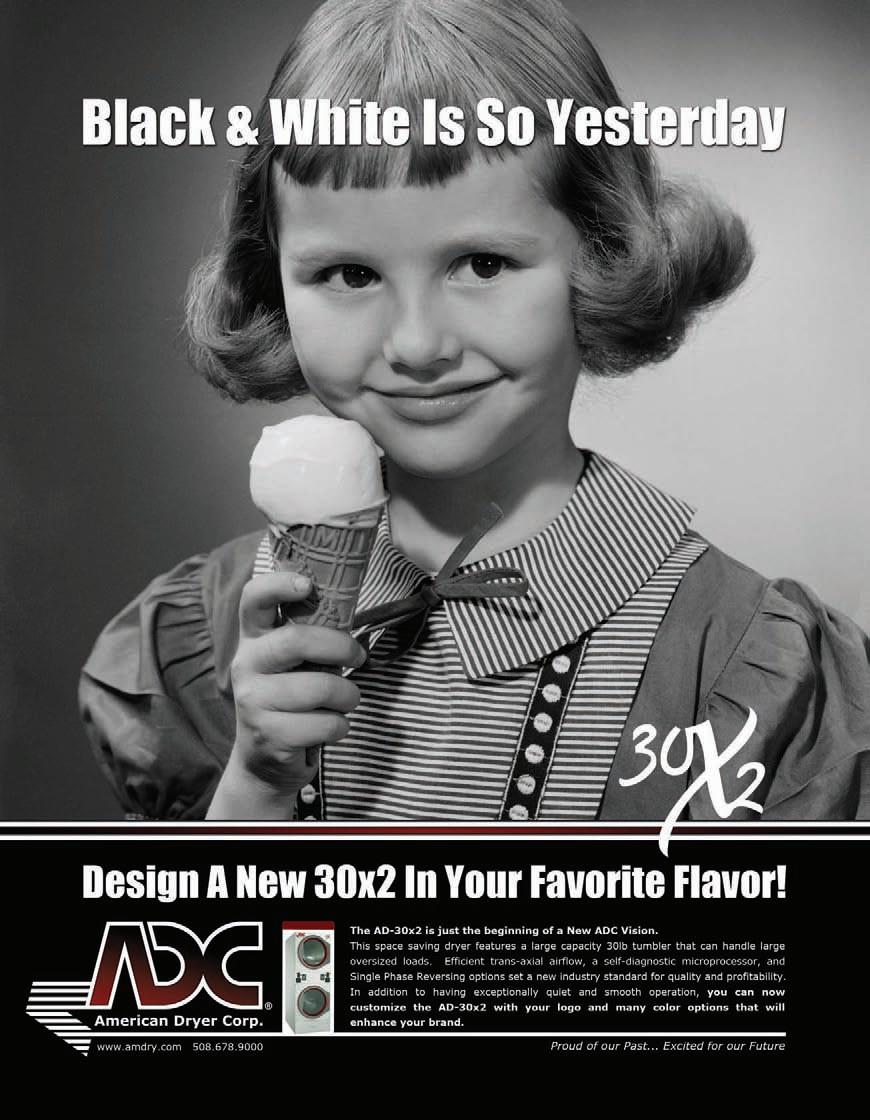










Let’s talk about expectations. The unwavering ability to get it right time and time again. Some people would say what you do best. For us, that’s making products that you can rely on to make your life easier and more it better, every day, every cycle. Grow your profitability by visiting a distributor open house. Learn more





A DISTRIBUTOR OPEN HOUSE.
that comes about from a deep dedication and passion for productive. We believe in taking what’s there and making at distributors.speedqueen.com or call 800.590.8872.
COIN-O-MATIC OF IL
April 18 3900 W. 127 th Street Alsip, IL 60803
HERMES EQUIPMENT

May 9 205 S. Lee Street Bloomington, IL 61701
MINNESOTA CHEMICAL CO.
April 16 N57 W13636 Carmen Avenue, Unit 4 Menomonee Falls, WI 53051
April 23 Kelly Inn Best Western 161 St. Anthony Avenue St. Paul, MN 55103
PWS
March 30 6500 Flotilla Street Los Angeles, CA 90040 March 30 365 Swift Avenue So. San Francisco, CA 94080
STAR DISTRIBUTING COMPANY, INC. May 7 3729 Charlotte Avenue Nashville, TN 37209


STATEWIDE LAUNDRY
March 19 and 20 Radisson Resort Orlando Celebration 2900 Parkway Boulevard Kissimmee, FL 34747
March 23 16375 N.W. 52 nd Avenue Hialeah, FL 33014
YANKEE EQUIPMENT
March 16 and 17 Westin Inn 70 3 rd Avenue Waltham, MA 02451
See for yourself why Speed Queen machines are the best in the industry by talking to one of our laundry experts. They’ll provide service training, help you grow your profitability and offer the best prices of the year. PROGRESSIVE

Ralph Wagner, who owns Wash ’n Dry Laundry Services in Morris, Ill., has been working in the coin laundry business for 14 years. His store an hour southwest of Chicago occupies 2,000 square feet and features Maytag equipment totaling 33 washers and 26 dryers.
Up until last June, his business was strictly a self-service laundry. But since then, his sales have risen 25%. Why? Wagner attributes it to an extra service he started last summer, one that many laundries may already offer: wash/dry/fold.
Getting into wash/dry/fold was something he and his wife had always wanted to try. Wash ’n Dry competes with a couple other Laundromats in the market of about 25,000 residents, but the economy and the lack of actual wash/dry/fold service in the vicinity pushed Wagner to pursue it.
“We feel right now, with the economy coming back, that (it was) a good time to start it,” he says. “In our area, we only had one other Laundromat that offered the service.”
Wagner reached out to Kevin Meyer, president of distributor Dolphin Laundry Service, Bensenville, Ill., to help him get started. “It’s a tough thing to get going, but it’s gone pretty well,” Wagner says. “A 25% increase in our revenue is pretty good.”
Chris Brick, regional sales manager for equipment manufacturer American Dryer Corp., explains that up to 80% of attended coin laundries in the United States offer some form of wash/dry/fold service. “Wash/dry/fold brings a different customer base to a lot of laundries.”
“Household washers (or) small equip-

“Household washers (or) small equipment within apartment buildings can have trouble handling comforters,” says Meyer, “so it solves a need for prospec-

tive customers.”
Considering the convenience such an added service offers to customers, it’s no wonder that many coin laundries have decided to cash in.
Dick Ruel, national sales manager at equipment manufacturer Maytag Commercial Laundry, attests to the profit potential. “If it were not for wash/dry/fold services, some laundries would not turn a profit.”
How much does such a service contribute to a store’s total gross revenue? Gary Gauthier, national sales manager for equipment manufacturer Milnor Laundry Systems, says it varies from store to store, while Meyer cites a range of less than 5% to up to 30%.

Considering how many laundries offer this service, what considerations must one take to truly profit from wash/dry/fold? Brick says the key to mastering the service starts with organization.
For stores looking to get into wash/dry/fold, Brick advises that owners start with a solid foundation of policies and procedures.
Having a protocol on how to accept and organize garments is the first thing owners should lay out prior to starting a service. Establish procedures for weighing a load and asking the customer if they want any pieces spot-treated or loads separated by whites and colors, for example.


I’ve personally handled insurance for hundreds of coin laundries! I’ve already dealt with most any issue your business is likely to face. If you have any questions about insuring coin laundries, I can and will give you a prompt, clear answer. Skeptical? Call me with a question and find out for yourself.
There’s more: I’m just one member of a team of experts at NIE. The entire organization has been handling fabricare insurance full time since 1915!
We are the only proper ty & casualty insurer devoted 100% to coin laundries and dry cleaners.
yclean Drop Store
“Taking responsibility for customer goods means understanding fabrics and carefully processing those items,” says Gauthier. “Make sure that your wash/dry/fold staff takes the time to evaluate the goods they accept to ensure that they aren’t damaged.”
With a plan in place, owners may then turn their attention to equipment and the possibility of investing in new machines.
The experts agree that any coin store can start a wash/dry/ fold service using the washers and dryers already in place, but there may be limitations.
“If all units within the store are top loaders, it limits your ability to process larger bulky items like comforters,” Meyer says. “[But] the majority of what a store will receive for wash/dry/fold is personals, which a typical coin store has sufficient machinery to handle.”
Wagner found this to be true, saying that he’s able to utilize the store’s current equipment for some of the customers he serves.
While he primarily processes residential wash/dry/fold, his initial goal was to go after commercial work. To date, Wagner has attracted business from what he calls “small commercial” accounts, catering to local hotels and senior housing facilities. For this reason, he installed a soaking tub and an Ecolab chemical and cleaning system for his machines.
Higher-capacity machines can process loads more quickly, but deciding which machines to invest in all goes back to a store’s policies and procedures, Brick says.
“If the customer wants to separate loads … then you’re going to use two smaller machines,” he says. “But if a customer does not want, or choose to separate (loads), then (you can) dump everything in a 60-pound (washer).
“In general, a 60-pound
washer can handle the vast majority of commercial account needs a Laundromat might have,” says Meyer regarding higher-capacity machines. “However, if a coin store is in a market where an 80-pound machine might give it an advantage for attracting self-service customers, then that should be taken into consideration.”
Utility efficiency, a large profile for easy loading and unloading, and a five-year manufacturer-backed parts
process residential accounts while self-service customers are using the store’s washers and dryers, he says.
“We’re a smaller market so there’s always downtime,” he explains, adding that late morning and early afternoon is when the store usually experiences a lull in traffic. “We have enough machines for our market where there’s always some machines open. Most (customers) drop off regular loads for just one or two machines at a time.”
With policies in place and any equipment issues resolved, the next consideration is employing an attendant.
Hiring an attendant should ultimately pay for itself, according to Brick.
your customer base (and) make them feel welcome (but) doesn’t mind washing, drying and folding clothes.”
Protecting your business against damage claims is another important issue to address, and that’s where insurance coverage comes into play. “With residential laundry, the standard insurance policy should suffice,” Meyer explains. But if a store wants to get into commercial accounts, “Owners should consult their broker to ensure the proper amount of liability insurance is in place.”
warranty are characteristics that Meyer looks for in assessing higher-capacity equipment.
Should a store that offers wash/dry/fold service make that equipment available to its walk-in customers? For Meyer, it’s all about catering to your customers, whoever they may be.
“We generally recommend making all equipment available to customers,” he says. “In practice, attendants will typically use the same one or two machines for wash/dry/fold accounts due to their proximity to the attendant station, or to high-visibility points in the store. But, there is no reason to limit availability.”
Though he limits his store’s cleaning system for commercial accounts strictly to employee use, Wagner has been able to

“To me, the better way to look at it is you would want a minimum of 50% of whatever their labor cost is to attend (their) laundry, they should try to generate in wash/dry/fold,” he says. “If you look at a guy that’s spending $60,000 a year in labor, to me he needs to generate at least 50% in wash/dry/ fold revenue, (or) $30,000.”
To keep labor costs down, Wagner, his wife, and, on occasion, his son and daughter pitch in to process the store’s wash/ dry/fold service. While his store only has one part-time employee that helps with the service, he plans on hiring a full-time attendant.
“We’d like to have one full-time employee hired by the end of the year,” he says. “Hopefully, we have enough accounts established (so) that we can maintain (it) and make it profitable.”
What qualities should a store owner look for in a candidate? Brick suggests seeking the right combination of experience and personality. Look for a person who has “a good personality, and someone that is going to communicate positively with
Besides the possibility of lost or damaged garments, there is another potential liability: “left items,” or items that customers forget they had brought in for laundering. Preventing these occurrences all goes back to an owner’s policies and procedures, and establishing a reliable tagging system, Brick says.
“When (a) customer comes in and they sign that ticket, some (stores) will take that ticket with a magnet and when that load goes into the wash, that magnet is stuck with that ticket on the wash,” Brick says. “When the load moves to the dry … the ticket never leaves the load.”
PRicing and TuRnaRound Charging by the pound is “the way to go now,” says Brick.
In his experience, Ruel has seen pricing range between 65 cents to $1.50 per pound. Brick says that some stores have a $5-10 minimum.
Meyer and Gauthier agree on the per-pound trend, but add that some laundries charge separately for bulky items such as comforters.
“Our recommendation is always determine your costs to process, and what the desired profit and price (is) accordingly,” says Meyer.
For Gauthier, transparency is key when it comes to pricing.
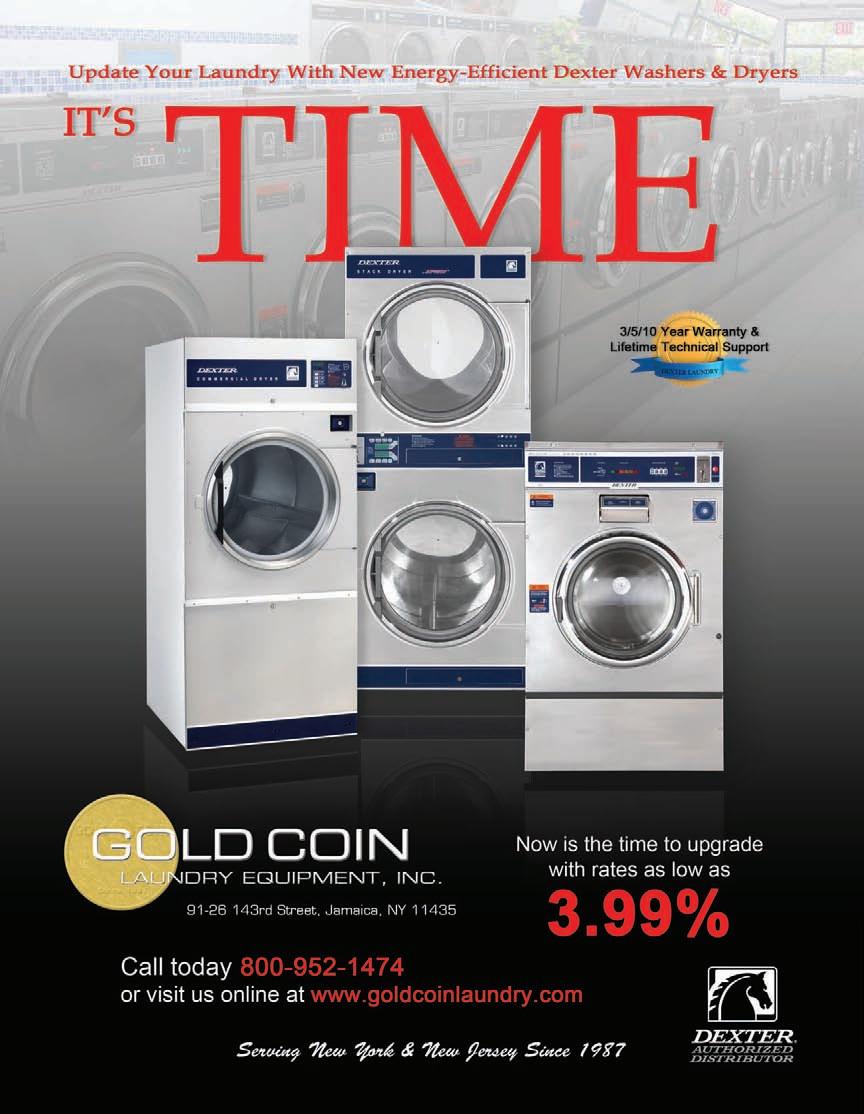
“It’s important to make sure that a store’s rates and policies are clearly published and easy to understand,” Gauthier says.
As for turnaround time, Brick explains that most fully attended laundries offer same-day service for garments brought in before noon. If a load is received later than that, many stores will have it done the next day.
But as with any business, rewarding loyalty is a top priority. If a regular customer brings something in and requests same-day service, “absolutely you provide that service for the regular customer,” he says.
“You try to go above and beyond to keep that business.”
SElling WaSh/DRy/FolDTaking the extra step to keep customers happy is one way to ensure that your wash/dry/fold service stays afloat, but what can owners do to extend their
reach to prospective customers?
Gauthier suggests that owners establish a strong online presence and consider investing in search engine optimization (SEO) services, such as Google AdWords, to attract business. “An established, effective online presence is a customer comfort and an inducement to try a new service. Roadside signs and direct mail are additional efforts, but they are typically limited to drive-by traffic and specific geographic territories.”
Store owners reaching out to community causes is another way to bring in new customers, according to Brick. For example, your store could host a fundraiser for a local church youth group or athletic team, and have them, alongside an attendant and adult volunteers, wash, dry and fold customers’ garments to raise money.
“Even if they split the revenue 50-50 … it’s a great way
for that organization to raise money, and it’s a great way for your Laundromat to get people (in) that may have never even thought about using the laundry for that service.”
Meyer, on the other hand, pushes the benefit of seasonal coupons, such as deals on comforter cleaning in the fall and spring. “It’s a good way to educate individuals who take advantage of the coupon and convert them to drop-off customers.”
The success of wash/dry/fold not only comes down to marketing, but how well versed attendants are in assisting customers, he says.
“If the attendants are supportive and educated enough to explain the drop-off service, it typically translates to a successful drop-off program,” Meyer says. “We have seen stores go as far as incentivizing attendants by commissioning them 5
The best strategy for offering commercial service, which is largely a business-to-business model, is putting yourself in the best position to do the job.
Plan to be actively involved in your commercial service, particularly in the beginning. Do some market research and find out what type of commercial work your competitors are doing, if any, before you set out to find accounts.
Take a look at your equipment mix. Does your laundry offer front loaders, top loaders, or a mix? How much capacity do you have? Are your washers programmable to adjust water temperature, cycle time, etc.?
Understand a potential client’s needs before agreeing to take on its work. For example, laundry containing heavy oils (restaurants) or petroleum products (garages or maintenance shops) will likely require care beyond the norm. Consult your chemical supplies distributor to determine what may be involved.
Examine your store’s layout. Is there enough space for folding stations, additional carts, etc., that will accompany the laundering of bulk linen? Review your insurance coverage to make certain it’s
to 10 cents per pound on orders they process.”
Marketing is all about staying in tune with the lifestyle of the community, Brick says. “You really have to look at each community. What is the avenue that my customer base looks at, reads (and) listens to, and that’s where you want to go to promote what you’re offering.”
You may want to consider adding delivery to your wash/ dry/fold service—which Brick calls a “great service” in urban markets—but tacking this on to your operation presents an added liability. “That’s when you would get into the extra insurance involved because you’re putting somebody on the road.”
Meyer echoes the sentiment, saying, “Delivery adds cost and opens the need for additional insurance coverage, as trans-
sufficient as your operation evolves.
Prepare a standard price list. And it’s best to have a written agreement or contract that clearly spells out terms of service.
Make certain that both you and your client are clear on when the clean linen is to be picked up or delivered. Don’t miss a deadline. Track your store’s activity, then process linen from commercial accounts during off-peak times as you’re able. Establish an organizational system so that you and/or your attendants can easily track orders and bill clients. Don’t sit back and wait for customers to come to you.
Publicize your commercial service on your store signage, advertising, website, etc. Take advantage of community networking opportunities (chamber of commerce, civic clubs, etc.) to build business relationships. Start small with a specific niche, such as a barber shop, dog groomer or youth camp, and build your client base from there.
Always be mindful of how your commercial service impacts your self-service business. You never want to discourage your walk-in customers.
portation becomes part of the equation. This needs to be balanced with the size of the delivery area (or) how much the potential market is increased through pick-up/delivery.”
But adding delivery could certainly be beneficial to the business. “We typically see the offering of delivery as viable and profitable,” Meyer says. “Some stores will charge a delivery charge as well to recoup related expenses.”
Though the idea of adding delivery to a store’s wash/dry/ fold service can attract customers looking for even more convenience, Brick estimates that less than 2% of laundries offer such an option.
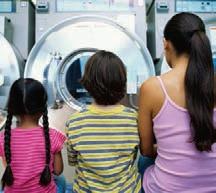 ThE FuTuRE oF Wash/DRy/FolD
ThE FuTuRE oF Wash/DRy/FolD
Many stores may wonder if starting, or even further developing, wash/dry/fold service is worth the risk. Brick admits that he’s seen some of the best
and cleanest stores “do everything right” but the service didn’t pan out. “It is kind of a fickle thing.”
Despite this, he believes the payoff is worth the gamble. Not only can owners make extra profit, their overall business can see a visible improvement.

“If you can afford to have that attendant there every hour that you’re open, the vandalism is reduced tremendously,” Brick says. “The store will be kept much cleaner, because you’ve got someone there wiping machines down (and) picking up softener sheets from the floor.”
ing, you can fix it right there for them or give them their money back. There’s never any miscommunication or issues, it’s all taken care of right away.”
With his wash/dry/fold
customer base. “I think you’ll see more stores begin to do more with the non-traditional laundry customer, meaning the people that have a washer and dryer at home.
“Because it’s a bigger (and) nicer store, they have no problems dropping their clothes off. I definitely think that wash/ dry/fold will become a stronger revenue source for laundries as they continue to build bigger, nicer, cleaner laundries.”
0612aco_Wells Fargo 7/17/12 3:56 PM Page 1
Wagner sees this improvement in his store, as having an attendant present “builds a confidence” in customers. “If (a customer) has a problem, instead of leaving a note or call-
service still in development, Wagner wants to hire a fulltime attendant, plus he has other goals in mind. “I’m just in the process of learning (but) we are looking for a second location with our distributor,” he says.
Larger stores are becoming the industry norm, according to Brick, which could lead to stores taking on commercial accounts and an expanded
All in all, for a wash/dry/fold service to really take off, it’s about creating a positive, lasting impression.
“The success of wash/dry/ fold will have more to do with who you hire, and what you put in place than just about anything else that you do,” says Brick. “The experience that you provide to that customer will lead to them coming back, and lead to them telling someone else.” n
Jodie Millino
Taking the extra step to keep customers happy is one way to ensure that your service stays afloat... {}


“We decided on ESD because they have a great reputation in this industry. They have been great to work with and provided us with great service and assistance in getting the CrossLinkTM system up and running smoothly.”

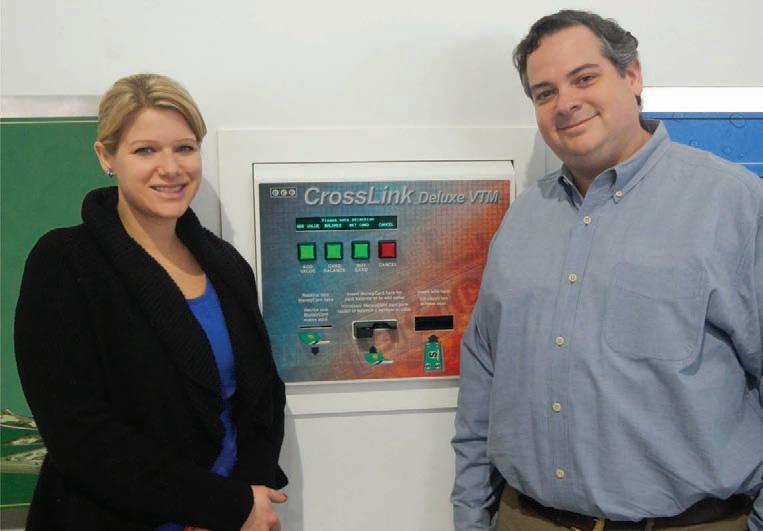


Owners Peter & Stephanie Herbein, Family Wash Day Super Laundry, Reading Pennsylvania

• Accept Credit And Debit Cards.
“The ESD CrossLinkTM system has allowed us to offer credit card use right at the machines. It seems to me that is the way our society is going. An all card all the time world.”
• Overwhelming Customer Acceptance.
• Customer Convenience By Having Alternate Payment Systems On The Same Machine.
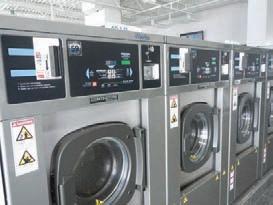


“I hope the CrossLinkTM system becomes the primary method of payment that our customers use. It’s easier for us and easier for our customers.”
• Create Your Own Personalized Loyalty Cards With Your Own Wash Reward Program. “I run daily specials and I like the flexibility to change pricing whenever I choose.”
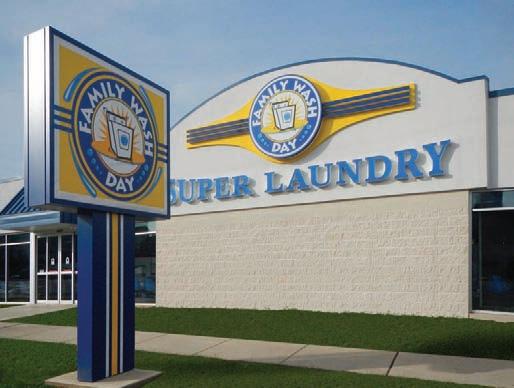
• Increase Revenue.
• Create Your Own Network. Track All Revenue! “I am surprised how self sufficient the system is once it is up and running.”
• Fits Virtually Every Machine.
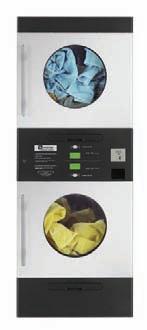
Dexter Laundry manufactures a complete line of dryers for the vended laundry industry, with machines ranging in capacity from 30 pounds to 80 pounds.
The dryers deliver maximum energy efficiency and superior drying speed, according to Dexter, by balancing heat input, tumble speed, air recirculation, and airflow through fully perforated, large-diameter cylinders.
Dexter dryers feature a welded solid steel cabinet structure, heavy-duty bearing housings, oversized bearings, as well as hardened steel trunionshaft assemblies, the company says. After a six-stage pre-treat process, each cabinet assembly is completely painted inside and out for maximum corrosion resistance. Extra-large loading doors are made of stainless steel, plus include full-view glass and easy-grip handles.
Maytag® Commercial Laundry now offers Energy Advantage™ Multi-Load Stack Dryers, which can potentially save laundry owners nearly 25% in energy and utility costs without increasing average dry time, the company says.


The dryers’ fast-drying axial airflow system, increased insulation and double-paned windows keep heat contained in the basket, enabling clothes to dry faster with a low-Btu output, according to Maytag.
Loaded with Built-To-Last™ features, the dryers have heavy-duty metal doors with tempered glass windows that cannot be pushed
Dexter dryers also feature solid-state microprocessor controls and electronic spark ignition.
Dexter introduced 30-pound and 50-pound Express Stack Dryers that offer greater cylinder capacity, along with fastdrying performance and low energy consumption. The Big Stack™ Express 50-pound stack dryer offers more capacity for store owners looking to maximize limited space, and it features large loading doors that are also available on the company’s 55-pound and 80-pound single-pocket dryers.
Dexter dryers are available in 30-pound, 30-pound stack, 50-pound stack, 55-pound, and 80-pound capacities. All are easy to install and require only single gas, electrical and exhaust connections, the company says.
dexterlaundry.com 800-524-2954
out; heavy-duty door hinges that are bolted through two layers of steel to protect the machine; and a magnetic door latch, providing a sealed drying process every time the door is closed.
The dryers also come standard with Maytag ComputerTrac® microprocessor controls, allowing operators to pre-program temperature and cool-down time to prevent over-drying.
The machines feature a modern look with rounded edges, and they are available in both stainless-steel and white finishes.
maytagcommerciallaundry.com 800-662-3587
Electrolux offers a full range of dryers engineered to cut drying time and lower energy consumption, according to Laundrylux, which distributes the equipment in the United States.
Electrolux 30x30-pound and 45x45pound stack dryers feature extra-large doors, shorter dry times and, according to the company, significant energy savings. EcoPower™ technology, standard on all models, saves up to 20% on energy consumption with every load, Laundrylux says. It is gentler on clothing and lowers operating costs for a coinoperated laundry. With Reversing Cylinders,
also a standard feature, garments don’t tangle and dry faster.
Electrolux 35-, 67- and 83-pound single-pocket dryers are equipped with axial airflow for low energy usage, and with Compass Pro Control, the same, easy-touse dial found on Electrolux Professional washers.



The company’s research shows a 12% faster drying time and 25% less energy consumption when using Electrolux dryers compared to similar models. laundrylux.com 800-381-7222

IPSO provides vended laundries with the ITT45, a 45-pound stack tumble dryer. The product line is industrial by design and built to extend linen life and reduce utility costs. The dryers feature intuitive controls and offer efficient technology, IPSO says.
The size and speed of the 45-pound stack dryer enables fast customer turnover. Though boasting 50% more rated volume than the 30-pound stack, the combined 90-pound unit enables stores to gain extra drying capacity without taking up extra floor space.
With two coin boxes, the stack doesn’t need to be emptied as often as a single tumble
dryer. A large, easy-clean lint filter also saves time.
Drywall screws and like-size fasteners that fall out of laundry items can cause extensive damage to the inside of a tumble dryer cylinder. But patented oblong perforations in the ITT45 serve as a protection against such destruction, says IPSO, enabling screws to pass harmlessly through to exit the cylinder.
An axial-airflow drying process ensures heated air passes through the load at the optimum point in the tumble process. Owners benefit from greater efficiency. ipso.com 800-872-4776
ontinental Girbau’s single-pocket ExpressDry Drying Tumblers are now available with a reversing option, the company says.
This feature continuously unbinds and untangles laundry items—notably sheets, large blankets and comforters—throughout the course of the dry cycle to deliver better drying quality, according to Continental. The option also ensures items come out of the dryer with fewer wrinkles in less time, it adds.
The ExpressDry tumbler, which is available in 30-, 55- and 75-pound capacities, offers programmability, durability, efficiency and ease of use. The machines require fewer Btu per load than many other dryers,

Continental says, and cut the amount of natural gas required to dry a load.
Engineered for constant use, ExpressDry dryers are equipped with rugged cylinders, dual motors and durable kick plates, cart bumpers and door bars to protect tumblers from outside impacts.
The machines feature microprocessor controls with easy-to-use graphic displays, advanced diagnostics systems and auditing capabilities. The control is programmable for time, temperature, cool-down and more.
ExpressDry vended dryers are compatible with coins, tokens or any card vending system on the market, the company says.
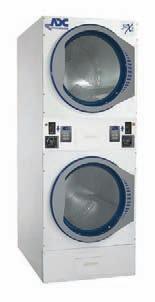

continentalgirbau.com 800-256-1073
ascomat’s full range of energy-saving dryers is designed with value, reliability, durability and customer satisfaction in mind for Laundromat owners, according to distributor Laundrylux. Wascomat’s 30x30-pound and 45x45-pound stack dryers feature extra-large doors, easy-to-use controls and shorter dry times. The company’s 35-, 67- and 83-pound single-pocket dryers are equipped with axial airflow for low energy usage, and with Compass Pro Control, the same, easy-to-use dial featured on its commercial washers.
Precision-engineered Wascomat dryers also feature sturdy drum suspension with double sealed bearings and belt drive, large and easy-to-clean lint filter, and support rollers for increased drum stability and noise reduction, Laundrylux says. laundrylux.com 800-645-2205

merican Dryer Corp. (ADC) recently introduced the AD-30x2, a 30-pound stack dryer, to its lineup.
The commercial laundry stack dryer incorporates state-of-the-art design features with simple controls and an easy-to-read LED screen. It includes efficient trans-axial airflow and rugged roller-supported tumblers.
A space-saving machine at only 311/2 inches wide and a little more than 40 inches deep, the AD-30x2 features large-capacity tumblers that can handle oversized loads.
The machine also has the option for single-phase reversing and is fast-drying and efficient, in addition to offering quiet, smooth operation, ADC says.
Exclusive to the AD-30x2 are various door-trim color options.
amdry.com 508-678-9000
Milnor coin-operated dryers provide gassaving, fast-drying units for coin laundries of any size, the company says. Available in either single-pocket or stack models, the machines deliver high performance and dependability in a small footprint.
Milnor now offers the coin-operated EcoDry dryer line. These dryers offer increased efficiency with a unique sensing system that measures the presence of moisture in the load. The microprocessor stops the dryer at desired set points, saving time and energy. A dual-paned
glass door seals heat inside the dryer and keeps it focused on laundry items.
The dryers are coin- or card readercompatible, with large, reversible doors to make loading and unloading easy.
Service access is easily accomplished through the front or rear of the units, Milnor says. Front panels are available in white, with a stainless steel option, and all models fit through a standard 36-inch door.
milnorcoin.com 504-712-7656


uebsch offers Laundromat owners 50- and 75-pound tumble dryers with reversing technology (three-phase only).
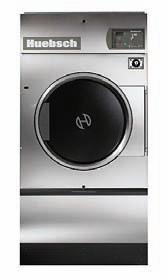
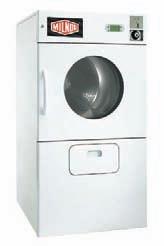
Reversing technology allows a machine to stop, pause, and then switch direction, helping to reduce balling or roping of large articles such as sheets, comforters and tablecloths, Huebsch says. Balling or roping causes the center of the linen to be less dry than the outside.
The reversing feature provides a consistent, even drying of laundry items. The feature also boosts productivity because employees will no
longer need to spend extra time untangling linen.
The machines are available with the Galaxy 600 control for tumblers, the complementary control to the Galaxy 600 washer-extractor control. The Galaxy 600 provides owners with advanced programming options for features such as the tumble dryer’s cycles, temperature or time, and pricing.
huebsch.com 800-553-5120
You’ve heard the expression, “Know your customer.” But what does it mean? How do you practice the art of knowing your customer when you’ve got machines to fix and commercial orders to get out? And maybe it’s a stupid statement anyway, because the customer is the one who puts the quarters in the slot. Of course, you know him or her.
Let’s talk about knowing your customer in the context of running a Laundromat, whether it’s a busy shop, a few stores or a chain. It means knowing what type of people your customers are, and why they come to you instead of your competitors.
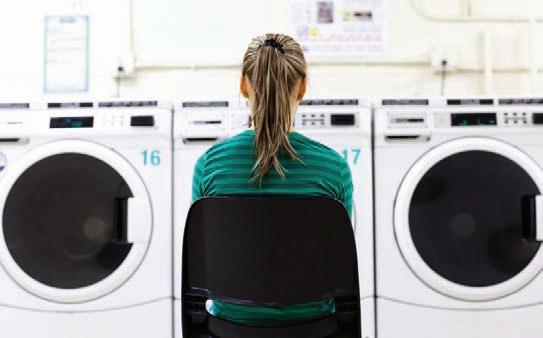
It means understanding their spending constraints and what could make them stop coming to you.

It means getting a sense of the ethnic diversity of your customer base and their lifestyle preferences.

It means getting a sense of what makes them tick.
So how do you do this? One option is to never be around but ask your staffer what types of people come in your store. But this method won’t work because your staffer won’t know what to say.
Another method is to be there all the time, talking and
chatting with the people who stop in. This won’t work too well either, because simply talking is not gaining insight. Besides, you’ll use up all your time in customer relations and have none left to devote to management.
Yet another option is to be there every day processing work while keeping your eyes and ears open. This will work somewhat, but it won’t expose you to their truths because only half your attention is focused on them. Personal interaction leads to much more insight.
The right way to know your customers is, whenever you’re there, to interact in a professional manner with them for a half-hour or hour, and then return to your tasks.
Speak to them and get a sense of their needs. You will banter about day-to-day matters, certainly, but find a way to ask questions. Your goal is to get them to talk about their laundry experience. Maybe, in the course of the conversation, they will reveal something worthwhile: “I wish so many of your machines wouldn’t break down so much.”
“If you go up in your prices again this year, I’m going to another Laundromat.”
“It’s so hard to park around here.”
“The place is so dirty, I wonder if my clothes are getting clean.”
“It’s too crowded on the weekends.”
“I wish you were open late at night.”
“It’s not right that there’s no one here at night to open the bathroom.”
“None of my friends come here at night because the neighborhood is too sketchy.”
Such insights would give you calls to action. For instance, if you heard that last concern enough, you could hire an attendant to work the store at night and walk every person
(when appropriate) to his or her car. You could counsel the staffer to talk about how safe the neighborhood really is, install extra fluorescent lighting that makes the place really bright, and install parking lot lighting. You could get involved in activism whose aim is to make the community safer, as well as hand out posters in nearby neighborhoods that emphasize the convenience and safety of doing laundry at your store.
Be hands-on with customers. If a customer complains about a machine, even if you’re dressed in a suit, take off your jacket and see what you can do to fix the problem. At minimum, make a note and see that the issue is taken care of promptly. If you have the customer’s address, send a note to that effect. Customers love the personal service, especially when the boss is involved. Furthermore,
Charge of Clothes Washing. Or how about a string of titles, something like Owner, Proprietor, President, Chief Cook and Clothes Washer? Or there’s The Man Who Has the Most Gray Hairs Because the Buck Stops at His Desk. Make light of your situation,
such hands-on activity shows staffers that you are really concerned with customer service.
Learn and remember names. If you are there only briefly to check on matters, and you spot a familiar customer walking in, continue with your work. But before you leave, walk over and say hello to this person. Call him or her by name. Ask about what’s new, and if they’re satisfied with your service. Listen to their answer carefully.
If you have trouble remembering names, make a mental note of a person’s unique characteristic and pair it with their name. For example, the “green sneaker guy” is named Garry. If you’re not able to do this, write down customer names in a notebook until you are able to commit them to memory.

Even if no one familiar comes in, after you finish work, go out among the customers. Tell them that you are the owner and ask for suggestions. Listen to what they say, then scribble down a note as well as their contact information so you can get back to them. Again, customers love the boss to be involved, and you’ll probably learn something. This activity is called “working the floor,” and a skilled owner can do it masterfully.
Hang up a picture of yourself. Make a show of laughing at yourself. Underneath the photo, print your “title,” such as CEO in
and the world will laugh with you.
In the quiet of your office, think about your customer and his or her needs in the light of what you have recently learned. Approach the task of laundering from your customer’s point of view. Ask yourself how you could make his or her life easier. What little thing would brighten his or her day?
I’ve always thought that restaurants that offer a free piece of candy with the bill do a little extra to make their customers feel happy about the eating experience. What candy-bit equivalent can you offer your customers?
Meet your customers where they are. You’ll soon understand what makes them tick and know how to make sure you see them again and again.
Howard Scott is a long-time business writer and small-business consultant. He has published four books.
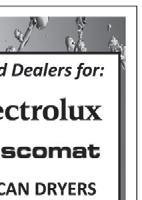
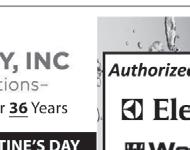
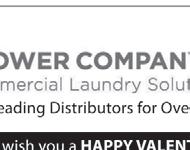


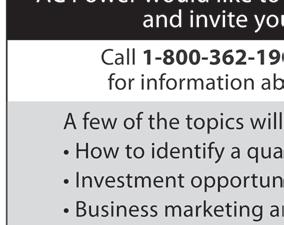
The U.S. population will be considerably older and more racially and ethnically diverse by 2060, according to projections released in December
by the U.S. Census Bureau. The projections of population by age, sex, race and Hispanic origin, covering the 2012-2060 period, are the first set based on the 2010 Census.
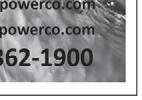
“The next half-century marks key points in continuing trends — the U.S. will become a plurality nation, where the non-Hispanic white population remains the largest single group, but no group is in the majority,” says Acting Director Thomas L. Mesenbourg.
Furthermore, the population is projected to grow much more slowly over the next several decades, compared with the last projections released in 2008 and 2009.
The population age 65 and older is expected to more than double by 2060, from 43.1 million to 92.0 million, and will represent just over one in five U.S. residents by the end of the period.
The non-Hispanic white population is
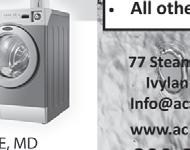


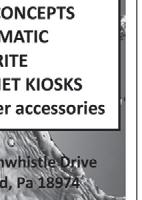
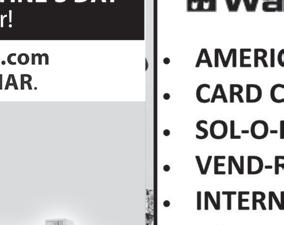
projected to peak in 2024, at 199.6 million, up from 197.8 million in 2012. Unlike other race or ethnic groups, however, its population is projected to slowly decrease, falling by nearly 20.6 million from 2024 to 2060.
Meanwhile, the Hispanic population would more than double, from 53.3 million in 2012 to 128.8 million in 2060. The black population is expected to increase from 41.2 million to 61.8 million over the same period. The Asian population is projected to more than double, from 15.9 million in 2012 to 34.4 million in 2060.
Among the remaining race groups, American Indians and Alaska Natives would increase by more than half from now to 2060, from 3.9 million to 6.3 million. The Native Hawaiian and Other Pacific Islander population is expected to nearly double, from 706,000 to 1.4 million.
All in all, minorities, now 37% of the U.S. population, are projected to comprise 57% of the population in 2060. The total minority population would more than double, from 116.2 million to 241.3 million over the period.
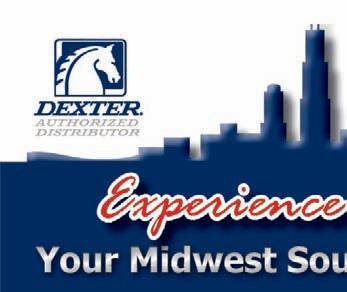





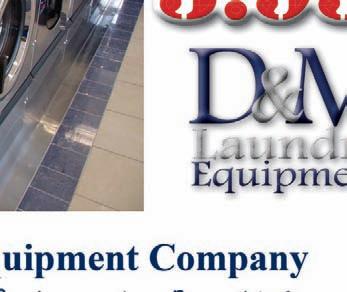



IRS Raises Standard Mileage Rates for 2013 (WE)
Book ’Em: New Orleans Housing, Clean Show Registration Now Open Finkelstein, Ristaino New Additions to CLA Board

PWS Schedules Service Schools Throughout 2013 (WE) U.S. Census Bureau Projects...
StatShot: November Sales Largely Positive; Front-Loader Prices Range from $1.50 to $15 (WE)
The Elements of Being Customer-Friendly

How to Handle a Tax Audit Holiday Stain-Removal Tips


From AmericanLaundryNews.com: IAHTM Announces Officers and Board Members for 2013
McCauley Named ARTA President; New Board Announced
From AmericanDrycleaner.com: The Structuring of Dry Cleaning Pricing
Plant Design Awards—Grand Prize: Rainbow Cleaners
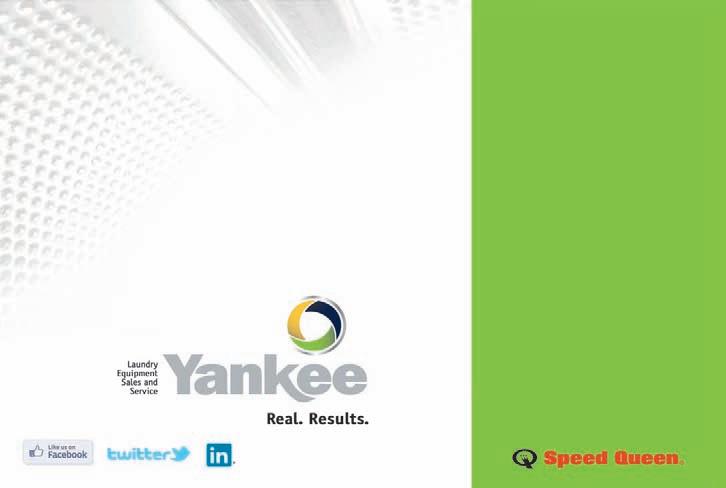

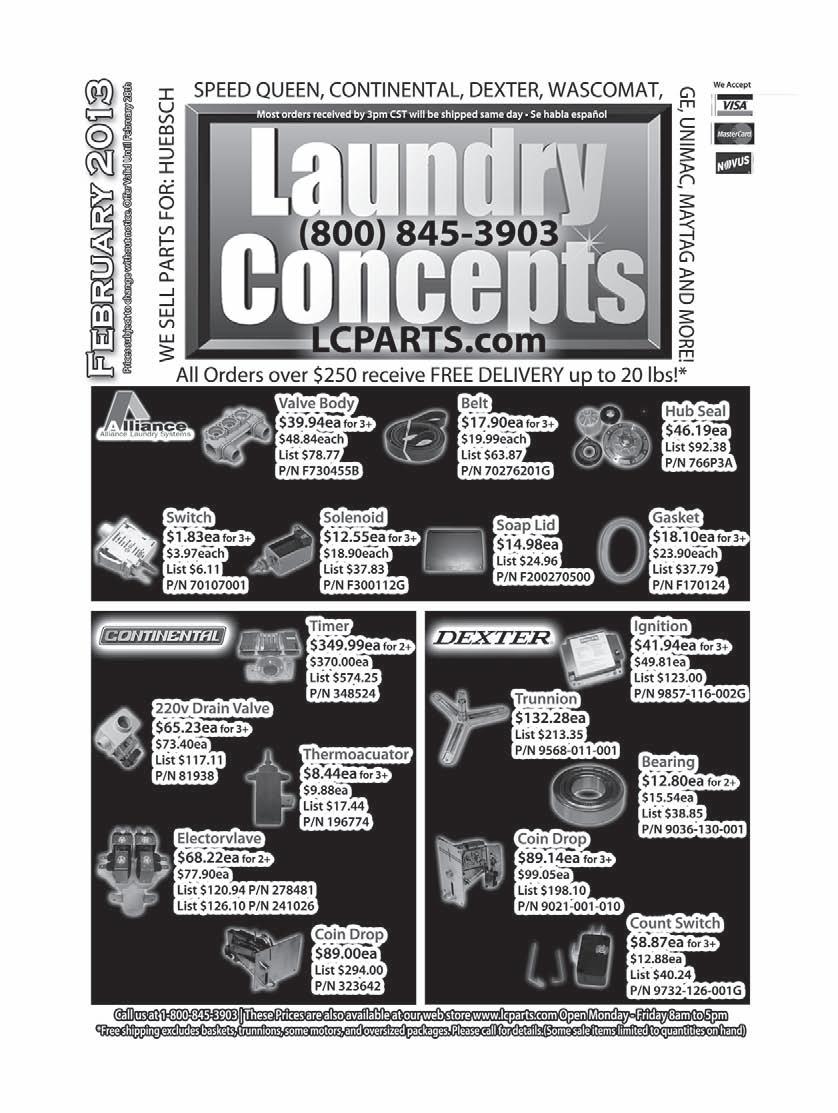
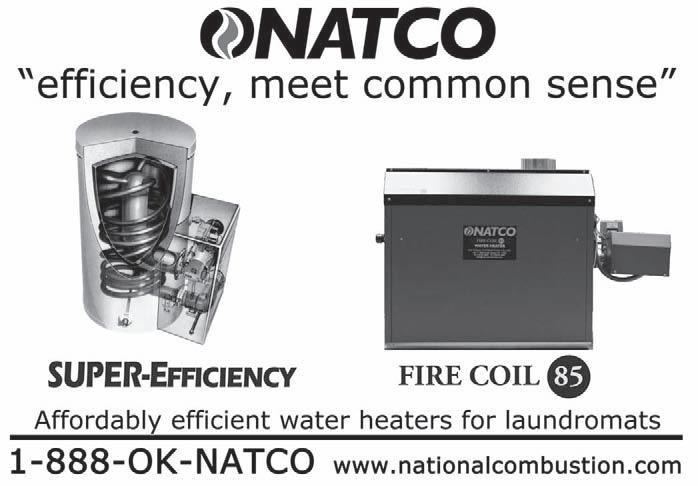
WASCO 185’s 220/1 & 220/3 $3,500
WASCO 184’s 220/1 & 220/3 $2,700
WASCO 125’s 220/1 & 220/3 $2,400
WASCO 124’s 220/1 & 220/3 $1,850
WASCO 74’s 110 v & 220/3 $ 975
WASCO 75’s 110 v & 220/3 $1,200
WASCO 620’s 110V $1,600
Our Parts Department has thousands of products on over an acre lot.
If we don’t have what you want, ask us, and we’ll find it for you.
From initial site inspections and recommendations to equipment purchase and installation, we are here to help with every aspect of your project.
We can help you with specifications, dimensions, illustrations of commercial and on-premise laundry equipment.


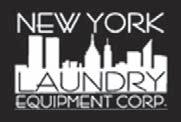
We are able to offer competitive rates and low, affordable monthly payments for financing coin laundry and laundromat facilities.
We have a coin laundry financing solution to meet the needs of new store owners, and veterans alike.
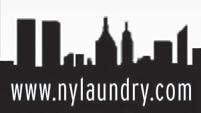
ACRES OF HARD TO FIND USED WASHER & DRYER PARTS WASHER & DRYER FRONT & SIDE PANELS ALL MAKES AND MODELS STARTING @ $50

WASHER DOOR $35 & UP COMPLETE DRYER DOOR $35 & UP COMPLETE ANY WASHER TUB 18#, 35#, 50#, WITH NEW BEARINGS $175 & UP WITH EXCHANGE ALL DRYER BASKETS $75 & UP ESD CARD READERS $150 EA

EMERALD SERIES COMPUTER BOARDS $575 EA
LET US REFURBISH YOUR PANELS ~ FRESHLY PAINTED PANELS IN EITHER ALMOND OR WHITE ... $70 EA
DIRECT LAUNDRY SYSTEM
98-47-212 St, Queens NY 718-468-1119 / 917-678-2095
Laundry Equipment Parts Repairs Bearing Job Over 20 Years’ Experience.

W 185 $3000.00 W 125 $1700.00 W 75 $900.00 W 184 $2800.00 W 124 $1600.00 W 74 $800.00 JT0300 $1800.00 JT32DG $1500.00
Lots of Washers, Dryers, Motors, Baskets, Gas Valve, Computers, Doors, Front & Side Panels etc. Washers comes with 2 Years Bearing, 1 Year Limited Parts & 90 Days Service in the NYC and Tri-State Area.

Many Brand Names not listed. Florida & Georgia area VICTOR @ 321-946-9890




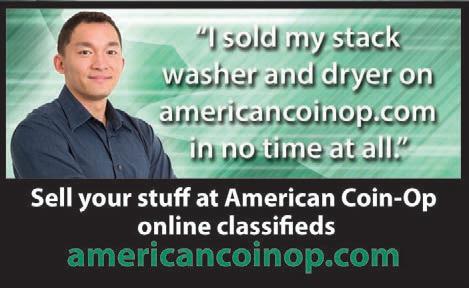
Feb. 12 is DeaDline to RetuRn economic census FoRms
Over the last two months, the U.S. Census Bureau in Washington has mailed 2012 Economic Census forms to 4.2 million U.S. businesses, including laundries and dry cleaners.
Those businesses that received this form are required by law to respond, and the deadline for submitting completed forms is Feb. 12.
All businesses have the option to file on paper or electronically. For more information or help completing the form, see the Census Bureau’s business help site at econhelp.census.gov or call 800-2336136.
The first 2012 Economic Census reports are slated for release next December.
DRought upDate: DRy conDitions expecteD to last at least thRough WinteR
The drought that swept across wide areas of the United States in 2012 was historically unusual in speed, intensity and size, and those dry conditions are expected to last at least through this winter, according to climatologists at the National Drought Mitigation Center at the University of Nebraska-Lincoln.
Forecasts show little hope of quick improvement, deepening the negative effects on agriculture, water supplies, food prices and wildlife.
“We usually tell people that drought is a slow-moving natural disaster, but this year was more of a flash drought,” Mark Svoboda, a center climatologist and an author of the weekly U.S. Drought Monitor, said in late December. “With the sustained, widespread heat waves during the spring and early summer coupled with the lack of rains, the impacts came on in a matter of weeks instead of over several months.”
The result, according to year-end Drought Monitor data: More than 60% of the contiguous 48 states and 50% of the entire country was in severe to extreme drought for significant portions of 2012, Svoboda said.
The first wave of drought impacts has been agricultural: The U.S. Department of Agriculture’s Risk Management Agency says indemnity payments for 2012 were at nearly $8 billion. The winter wheat crop outlook across the Great Plains has been reduced, and ranchers are scrambling to find feed for cattle. Hay prices have risen, likely meaning bigger grocery bills as meat and dairy prices climb in response.
The second wave of impacts is often hydrological, according to Brian Fuchs, also a monitor author and center climatologist.
“In the Southeast and southern Plains, multiple years of drought have resulted in widespread hydrological drought issues with water supply and water quality as well as with declining storage and water tables,” he says. “In areas where the drought has been shorter, such as in the Midwest and Plains, there are some water systems that are already under stress and more impacts related to hydrologic drought will develop as the drought continues.”
Finkelstein, Ristaino neW aDDitions to cla boaRD
The Coin Laundry Association (CLA), Oakbrook Terrace, Ill., reports the election of two new additions to its 2013 Board of Directors: Michael Finkelstein and Ted Ristaino.
CLA’s board is comprised of association members who volunteer time and talent to represent the majority of the membership in policy and decision-making processes.
Finkelstein is a multi-store laundry owner based in Danville, Va. He serves as president and CEO of Associated Services Corp. In the past seven years, Finkelstein has been an active CLA member, participating in panels on multi-store issues for the association.
Ristaino is president of Yankee Equipment Systems, a distributor specializing in equipment for “an enormous range of industries,” CLA says. He has been involved in the laundry industry for nearly 45 years and has been an active member of CLA’s New England chapter for 20. As a NECLA board member, Ristaino has rewritten laws, retained a lobbyist, and enhanced the relationship between NECLA and CLA members.
Six other candidates—Jeffrey Barman, Deborah Dower, Joel Jorgensen, Ron Kelley, George Pierce and James Whitmore—were re-elected to the CLA board for their service and commitment to the industry.
lg appoints gutieRRez national sales manageR FoR commeRcial launDRy Industry veteran Gustavo Gutierrez has been named national sales manager of Commercial Laundry Systems for LG Electronics USA, Englewood Cliffs, N.J., the company reports.

Gutierrez brings more than two decades of experience to his new role at LG, where he will be responsible for developing and managing programs to differentiate LG in the coin/OPL and route/multi-housing markets in the United States.
“Gustavo’s extensive experience in the commercial laundry industry will take our leadership to the next level as we work to become a significant player in the U.S. marketplace,” says Stefan Meir, Commercial Laundry director, LG Electronics USA. “His vision and leadership will help lead to the continued expansion of our route network, as well as attracting new, high-quality distributors.”
Gutierrez comes to LG Electronics from Mac-Gray, where he served as a route sales manager in the South Florida market. While there, he also launched The Bid Shop, an online platform to connect service professionals with companies looking for proposals.
“LG’s innovative laundry products offer an exciting opportunity for our distributor network,” says Gutierrez. “My focus is to build on LG’s momentum to help the business grow further and enjoy a similar strong reputation in the commercial space as it has in the consumer laundry market.”


